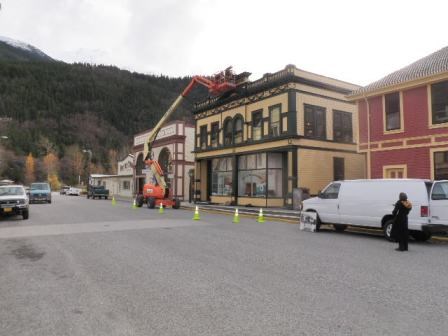
NPS A Brief History of Preservation in Skagway and Klondike Gold Rush National Historical Park The preservation of Skagway's history including its structures, (artifacts of the Klondike Gold Rush 1897-1898), began with the early residents of Skagway. The pioneering cabin of Captain William Moore, founder of Skagway, was saved by his son Ben in 1900 because of its historic value. Today, visitors to Klondike Gold Rush National Historical Park can tour the cabin (built in 1887) on their own or through a self-guided walking tour of park buildings in the Skagway Historic District. The first few decades of Skagway's history witnessed the removal of what were thought at the time as "unsightly shacks" and the beginning of a town "beautification" project which included the relocation of many buildings to the central core of town on Broadway Street. (L.S.Spude, 1983). Inspired by a sense of pride in their history, and the realization that Skagway's history was important to the town's growing tourist economy in the 1920's and 1930's, several Skagway residents were led to expand their preservation efforts. Some of these pioneers of Skagway preservation were Harriet "Ma" Pullen, the Kirmse Family and Martin Itjen. Harriet preserved the oral history of Skagway by telling tales of the Gold Rush to her hotel guests and showing Gold Rush memorabilia in her Pullen House museum. The Kirmse family, and others in town, also shared and preserved memorabilia from the Gold Rush by displaying these items in their stores or keeping them protected in their homes. Martin Itjen told the history of Skagway to tourists on his famous "Streetcar" tours, cared for the Gold Rush Cemetery grounds, preserved Soapy Smiths saloon and numerous gold rush artifacts, and wrote about the local history. Later on in the mid 1960's, George Rapuzzi, a Skagway history enthusiast, took over the care of Soapy's Parlor and many of the artifacts that Itjen had been displaying. Soapys saloon recently underwent a major restoration by the preservation staff at Klondike Gold Rush. The dedication of "Jeff Smiths Parlor Museum", as it was when George Rapuzzi owned the museum, coincided with the National Park Service centennial celebration in 2016.
Currently the Klondike Gold Rush Preservation maintenance team has several major historic structure restorations under way. These are multiple phased projects which typically have a five to six year goal for completion. These projects are the first YMCA Gymnasium in Alaska, the Arctic Meat Company building, and the last existing refrigerated warehouse in Skagway; the "Frye-Bruhn Cold Storage Building."
We are guided by a series of laws beginning with the Antiquities Act passed by Congress in 1906. These laws, however, did not give us specifics as to what materials should be used and the methods for using those materials. It wasn't until 1979 when the NPS and all those interested in preservation received a guidebook for materials and methods. The Secretary of the Interior's Standards for the Treatment of Historic Properties defines four specific treatments with guidelines and standards to follow for each treatment. Those treatments are Preservation, Rehabilitation, Restoration, and Reconstruction. Learn more about these treatments and for technical guidance and look for the tabs on "Standards" and "How to preserve." Here you will find the Secretary of the Interiors Standards for the Treatment of Historic Properties, Preservation Briefs and Preservation Tech Notes that will guide you through the process. At this site you can also find information on tax incentives to preserve historic structures, sustainability, education and training. View the list of available publications on preservation.
L.S. Spude, R. (1983). Building the Gateway to the Klondike. Anchorage: Alaska Regional Office of the National Park Service. Written by Klondike Gold Rush NHP Preservationist Lisa Cassidy |
Last updated: September 12, 2024
